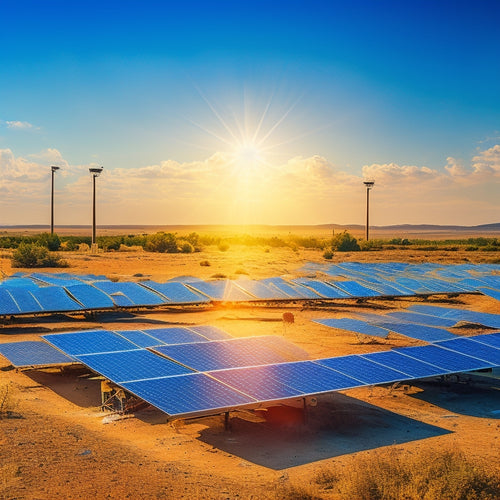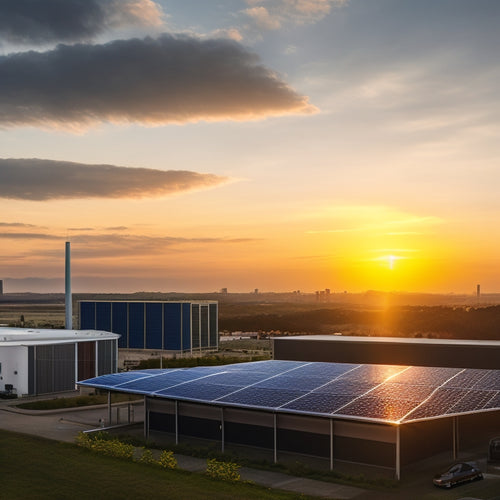
Small Off Grid Solar System
Share
You're considering a small off-grid solar system to power your home, which means you're taking the first step towards energy independence and greatly reducing your reliance on the grid. This system will generate clean, renewable energy, reducing your energy costs and carbon footprint. To design a superior system, you'll need to calculate your daily power needs, considering appliance wattage and usage duration. Properly angled solar panels, maximizing energy output, and integrating Maximum Power Point Tracking (MPPT) technology will further enhance your energy harvesting capabilities. Now, you're ready to uncover the specific details that will make your off-grid solar system a success.
The Essentials
- A small off-grid solar system provides energy independence and reduces reliance on the grid, promoting financial control and uninterrupted power supply.
- Off-grid solar systems significantly reduce carbon emissions, contributing to a smaller carbon footprint and a cleaner environment.
- A well-designed off-grid solar system must be tailored to daily energy needs, considering total watt-hours required for appliances and energy consumption habits.
- Solar panel efficiency and optimization are crucial for maximizing energy production, with monocrystalline panels offering higher efficiency at a greater cost.
- Proper energy management through MPPT technology and controller selection is vital for maximizing energy production and improving overall system performance.
Energy Independence at Home
You're taking a major step towards energy independence at home by installing a small off-grid solar system.
This setup allows you to power your daily life with clean, renewable energy, reducing your reliance on the grid. By generating your own electricity, you'll greatly cut down on your energy bills, giving you more control over your energy expenses.
With an off-grid solar system, you'll enjoy uninterrupted power supply, even in areas with frequent power outages, and reduce your carbon footprint by utilizing the power of renewable energy.
Powering Your Daily Life
Achieving energy independence at home requires a well-designed small off-grid solar system capable of powering your daily life. You'll need to take into account several key factors to guarantee your system meets your energy needs. A solar battery provides energy storage, allowing you to access power when the sun isn't shining. Portable systems offer flexibility, but may not be suitable for full-time off-grid living.
| Component | Considerations | Importance |
|---|---|---|
| Inverter Choice | Efficiency, compatibility with appliances | High |
| System Sizing | Accurate calculation of energy needs | High |
| Maintenance Tips | Regular checks, cleaning, and troubleshooting | Medium |
When choosing an inverter, think about its efficiency and compatibility with your off-grid appliances. Proper system sizing is vital to make sure you have enough power to meet your daily needs. Regular maintenance is important to prevent system failures and optimize performance. Additionally, take into account the impact of weather on your system's performance and plan accordingly. With a well-designed system, you can enjoy the freedom and independence that comes with living off the grid.
Reducing Energy Bills
By opting for a small off-grid solar system, homeowners can markedly reduce their energy bills and take an essential step towards energy independence at home.
This reduction in energy bills is a direct result of generating your own electricity, rather than relying on the grid. With a small off-grid solar system, you can expect significant energy savings, leading to substantial cost reduction over time.
Furthermore, designing and installing a reliable off-grid solar system that meets your unique energy needs can be achieved with the help of all-encompassing solutions that address complexity and uncertainty renewable energy solutions.
You'll be utilizing the power of the sun to fuel your daily activities, from powering lights and appliances to charging your devices. As a result, your reliance on the grid will diminish, and your energy bills will decrease accordingly.
Low Carbon Footprint
By installing a small off-grid solar system, you're taking a significant step towards reducing carbon emissions from your home.
You'll be generating electricity from a renewable energy source, which means you'll be shrinking your carbon footprint.
Additionally, with residential solar panels, you can reduce your energy bills and shift away from fossil fuels green energy systems.
As you shift away from fossil fuels, you'll also be contributing to a cleaner, healthier environment.
Reducing Carbon Emissions
You're taking a significant step towards reducing your carbon footprint by investing in a small off-grid solar system. This decision not only benefits the environment but also contributes to your independence from the grid. To further minimize your carbon emissions, consider implementing the following sustainable lifestyle choices and carbon offset strategies.
| Sustainable Lifestyle Choices | Carbon Offset Strategies |
| Avoid single-use plastics | Invest in reforestation projects |
| Use energy-efficient appliances | Support renewable energy projects |
| Conserve water | Purchase carbon credits |
| Implement recycling programs | Offset flights with carbon-neutral options |
| Use public transport or walk/bike | Invest in local clean energy initiatives |
Renewable Energy Sources
As you shift to a small off-grid solar system, you're tapping into a wider range of renewable energy sources that greatly reduce your carbon footprint.
You're no longer limited to traditional fossil fuels, and you're opening yourself up to a cleaner, more sustainable future. Geothermal energy, for instance, utilizes the Earth's natural heat to generate power.
Wind power and hydroelectric systems also become viable options, providing a reliable source of energy. Biomass energy, which converts organic matter into fuel, is another alternative.
And for coastal areas, tidal energy can be a transformative solution.
But what about energy storage? That's where battery technologies come in, allowing you to store excess energy for later use.
Hybrid systems, which combine multiple energy sources, can provide even greater reliability.
Solar thermal systems, which use the sun's heat to generate power, are another option.
And if you're not ready to go solo, community solar programs allow you to share the benefits of solar energy with your neighbors.
With these renewable energy sources at your disposal, you're free to live life on your own terms, unshackled from the grid.
Maximum Power Point Tracking
You'll want to enhance your small off-grid solar system's energy harvesting by ensuring your solar panels operate at their maximum power point, which is essential for efficient renewable energy storage and reducing your reliance on utility bills.
By incorporating MPPT, you can also make the most out of your solar panel array, even on cloudy or partially shaded days.
Maximum power point tracking (MPPT) helps you achieve this by continuously monitoring the panels' voltage and current output to identify the ideal operating point.
Solar Panel Efficiency
By the early 2000s, solar panel efficiency had become a major concern in the renewable energy sector. As you consider your small off-grid solar system, understanding solar panel efficiency is vital.
It's directly related to the amount of energy your system produces. You want to maximize energy output while minimizing costs.
Solar panel efficiency depends on the type of solar panel materials used. Monocrystalline silicon panels are more efficient than polycrystalline silicon panels, but they're also more expensive.
Thin-film panels are less efficient but cheaper. When choosing solar panels, you need to balance efficiency with cost.
A more efficient solar panel will produce more energy per unit area. This means you'll need fewer panels to meet your energy needs, which can reduce your overall system cost.
Additionally, more efficient panels tend to have a longer solar panel lifespan, which can save you money in the long run. When selecting solar panels, look for high-efficiency options that fit your budget.
Optimizing Energy Harvesting
Maximizing energy output from your small off-grid solar system requires more than just selecting efficient solar panels. You need to enhance energy harvesting by confirming your system operates at its maximum power point (MPP).
Maximum Power Point Tracking (MPPT) is a technique that continuously monitors and adjusts your system's voltage and current to achieve the best energy output.
To enhance energy harvesting, you'll need to evaluate solar panel orientation. Proper orientation guarantees your panels receive the maximum amount of sunlight, resulting in increased energy production.
You should also evaluate the type of MPPT controller that suits your system's requirements. A good MPPT controller can increase energy output by up to 30%.
When selecting an MPPT controller, evaluate the compatibility with your energy storage solutions. Confirm the controller can efficiently charge your batteries and power your appliances.
Assess Your Energy Requirements
To design an efficient small off-grid solar system, you need to understand your energy usage patterns and determine your daily power needs.
Considering the various components of off-grid power systems, such as portable solar power kits, is essential to ascertain a reliable energy supply.
You'll want to calculate the total watt-hours required per day, factoring in the appliances and devices you plan to power.
Energy Usage Patterns
Evaluating your energy requirements involves understanding your daily energy usage patterns, which is vital in determining the size and type of off-grid solar system you need.
To do this, you'll need to assess your energy consumption habits, identifying usage trends and seasonal variations that impact your overall energy needs. Peak times, such as morning and evening when lights and appliances are in use, will also influence your energy requirements.
Making lifestyle adjustments to reduce energy consumption can greatly affect the size of your off-grid solar system. For instance, using energy-efficient appliances and turning off lights and devices when not in use can lower your energy needs.
Energy monitoring through smart devices can help you track your consumption habits and identify areas for improvement. By making behavioral changes, you can optimize your energy usage and reduce your reliance on the grid.
Understanding your energy usage patterns is essential in designing an off-grid solar system that meets your unique needs and provides the freedom you desire.
Daily Power Needs
With your energy usage patterns in mind, you're ready to calculate your daily power needs, an essential step in sizing your off-grid solar system. To do this, you'll need to determine your total daily energy consumption in watt-hours (Wh).
Start by identifying your peak usage periods, such as morning and evening when lights, appliances, and electronics are in use. Calculate the total wattage of each device and multiply it by the number of hours it's used daily.
Next, consider energy conservation strategies to reduce your overall consumption. Look for opportunities to replace inefficient appliances with energy-efficient alternatives, and adjust your habits to minimize energy waste. This won't only reduce your carbon footprint but also decrease the size and cost of your solar system.
Once you've calculated your total daily energy needs, you can begin sizing your off-grid solar system. This will involve determining the required solar panel array size, battery capacity, and inverter rating to meet your energy demands.
Higher Energy Harvest Rate
You'll want to optimize your solar panel's angle to maximize energy production.
By adjusting the tilt and orientation of your panels, you can increase the energy harvest rate by up to 40%.
Properly angled panels can capture more sunlight, resulting in a higher energy yield and a more efficient off-grid solar system.
Optimize Panel Angle
Efficiency is the lifeblood of any off-grid solar system, and optimizing panel angle is an essential step in maximizing energy harvest rate. You'll want to guarantee your solar panels are tilted at the perfect angle to capture the most sunlight. This involves solar panel tilting, which can be adjusted seasonally to account for the sun's changing position in the sky.
During the summer months, the sun is higher in the sky, so you'll want to tilt your panels at a shallower angle to maximize energy production. In the winter, the sun is lower, so a steeper angle is more effective. By making these seasonal adjustments, you can increase your energy harvest rate by up to 10%. It's a simple but vital step in getting the most out of your small off-grid solar system.
To optimize panel angle, you'll need to take into account your location's latitude and the time of year. You can use online tools or consult with a solar expert to determine the ideal tilt angle for your specific system.
Frequently Asked Questions
Can I Use a Small Off-Grid Solar System for My Cabin or Tiny Home?
You're wondering if you can utilize solar power for your cabin or tiny home. Absolutely! You'll need to take into account design factors and assess your power needs to guarantee a seamless off-grid experience, giving you the freedom to thrive in your remote retreat.
Are Small Off-Grid Solar Systems Suitable for Areas With Low Sunlight?
You're wondering if areas with low sunlight can still utilize solar power. Yes, you can! Opt for high-efficiency solar panels and reliable energy storage options to guarantee a steady supply, even on cloudy days, giving you the freedom to thrive off-grid.
Can I Expand My Small Off-Grid Solar System in the Future?
As you gaze into the horizon, envisioning an energy-independent future, rest assured you can scale up your system to meet growing energy needs - modular designs allow seamless system expansion to keep pace with your developing power demands.
Do Small Off-Grid Solar Systems Require Regular Maintenance?
You'll need to perform routine checks to guarantee your system's longevity, as neglecting maintenance can lead to reduced efficiency and shortened lifespan; aim to inspect and clean your solar panels every 6-12 months to maintain peak performance.
Are Small Off-Grid Solar Systems Compatible With Lithium-Ion Batteries?
You'll find lithium-ion batteries offer advantages like high energy density and low self-discharge, making them compatible with your off-grid setup; they're a popular choice due to their high battery compatibility, ensuring reliable power storage for your freedom-driven lifestyle.
Final Thoughts
As you commence your off-grid solar expedition, envision a life where energy independence is no longer a dream, but a reality. Your low carbon footprint will be the envy of your neighbors, and with maximum power point tracking, you'll be utilizing every last watt of energy. By evaluating your energy requirements, you'll be able to optimize your system for maximum efficiency. And with a higher energy harvest rate, you'll be basking in the freedom that comes with generating your own clean power.
Related Posts
-

What Happens Without a Charge Controller in Solar Panels
Without a charge controller in your solar panel system, you risk overheating batteries due to overcharging, which can...
-

Why Outdoor Solar Lighting Systems Are Sustainable
Outdoor solar lighting systems are sustainable because they utilize renewable energy, drastically reducing your carbo...
-

Advantages of Commercial Solar Battery On-Site Storage
By investing in a commercial solar battery on-site storage system, you can greatly reduce your energy grid dependence...


